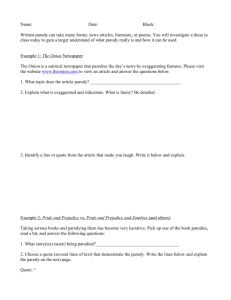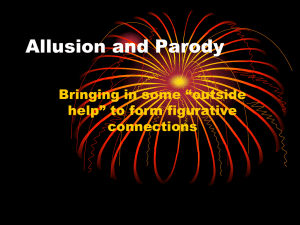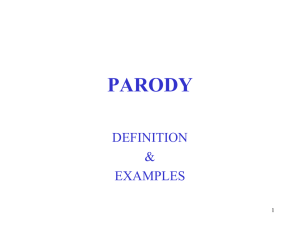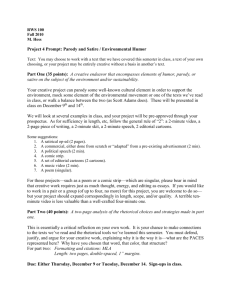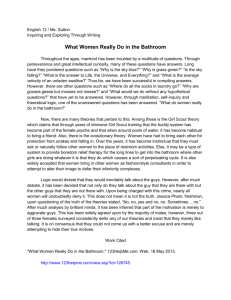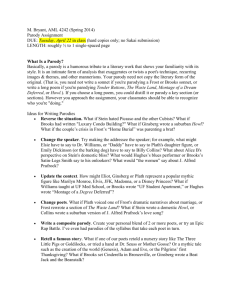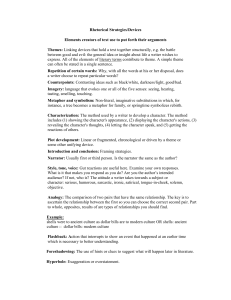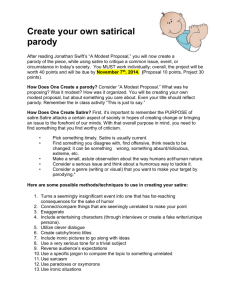Parody
advertisement
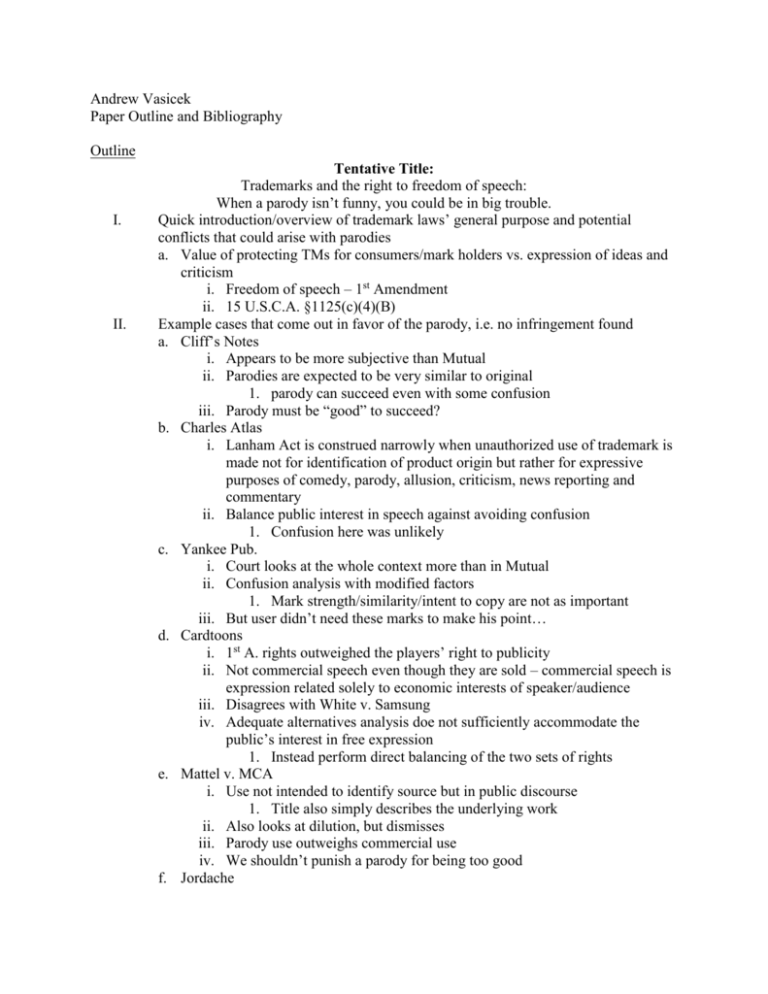
Andrew Vasicek Paper Outline and Bibliography Outline I. II. Tentative Title: Trademarks and the right to freedom of speech: When a parody isn’t funny, you could be in big trouble. Quick introduction/overview of trademark laws’ general purpose and potential conflicts that could arise with parodies a. Value of protecting TMs for consumers/mark holders vs. expression of ideas and criticism i. Freedom of speech – 1st Amendment ii. 15 U.S.C.A. §1125(c)(4)(B) Example cases that come out in favor of the parody, i.e. no infringement found a. Cliff’s Notes i. Appears to be more subjective than Mutual ii. Parodies are expected to be very similar to original 1. parody can succeed even with some confusion iii. Parody must be “good” to succeed? b. Charles Atlas i. Lanham Act is construed narrowly when unauthorized use of trademark is made not for identification of product origin but rather for expressive purposes of comedy, parody, allusion, criticism, news reporting and commentary ii. Balance public interest in speech against avoiding confusion 1. Confusion here was unlikely c. Yankee Pub. i. Court looks at the whole context more than in Mutual ii. Confusion analysis with modified factors 1. Mark strength/similarity/intent to copy are not as important iii. But user didn’t need these marks to make his point… d. Cardtoons i. 1st A. rights outweighed the players’ right to publicity ii. Not commercial speech even though they are sold – commercial speech is expression related solely to economic interests of speaker/audience iii. Disagrees with White v. Samsung iv. Adequate alternatives analysis doe not sufficiently accommodate the public’s interest in free expression 1. Instead perform direct balancing of the two sets of rights e. Mattel v. MCA i. Use not intended to identify source but in public discourse 1. Title also simply describes the underlying work ii. Also looks at dilution, but dismisses iii. Parody use outweighs commercial use iv. We shouldn’t punish a parody for being too good f. Jordache III. i. No confusion/dilution ii. Intent to parody existing trademark does not support inference of likelihood of confusion, as intent to parody is not an intent to confuse the public iii. Parody actually would increase awareness of Jordache mark iv. The benefit to the one making the parody, however, arises from the humorous association, not from public confusion as to the source of the marks. A parody relies upon a difference from the original mark, presumably a humorous difference, in order to produce its desired effect. g. Hormel i. No likelihood of confusion or dilution ii. Clear parody – no evidence of bad faith 1. Parody was obvious (lack of subtlety) iii. User frequently parodies famous marks/celebrities 1. Muppet itself did not cause confusion by appearance; different contexts 2. No evidence of bridging the gap into muppet performances for Hormel Example cases that come out in favor of the original, i.e. infringement found a. Anheuser-Busch i. Likelihood of confusion analysis ii. Ad was too much like a real ad; no disclaimers, etc. iii. No absolute right to use parody or to stop parody iv. Still must weigh value of parody against consumer confusion b. Mutual of Omaha i. Traditional likelihood of confusion analysis used ii. Adequate alternative avenues of expression iii. Using their property to criticize an unrelated thing iv. Parody must be distinguishable c. PETA i. Parody must convey two simultaneous and contradictory messages: that it is the original, but also that it is not the original 1. The domain name does not convey anything except that it is related to PETA 2. The content of the website is not simultaneous to the domain name a. Seeing name and accessing website are not simultaneous? ii. User was also indirectly using the site to sell a book iii. Parodies cannot use the same exact name as the TM d. Eli Lilly v. Natural Answers i. Confusion and dilution found ii. A "parody" is a humorous or satirical imitation of a work of art that creates a new art work that makes ridiculous the style and expression of the original iii. PROZAC is fanciful and gets higher protection iv. Natural Answers does not even attempt to point out any humor or satire in its imitation of the PROZAC mark. More important, even if a junior mark IV. meets the definition of a parody, it still runs afoul of the trademark laws if it is likely to confuse consumers e. Elvis Presley Enterprises i. Parody is one of the factors to consider in likelihood of confusion analysis ii. In case of standard likelihood-of-confusion analysis in trademark infringement case, successful parody of original mark weighs against likelihood of confusion because, even though it portrays the original, it also sends message that it is not the original and is a parody, thereby lessening any potential confusion. iii. Parody of faddish bars of the sixties did not require use of "Elvis Presley" or "Elvis" marks, because it did not target Elvis Presley f. ETW i. Use of professional athlete's trademarked name on back of envelope containing artist's print and in narrative description of the print was noninfringing fair use; use was purely descriptive and there was no evidence of bad faith. ii. Fact that expressive materials are sold does not diminish degree of protection to which they are entitled under First Amendment iii. Where false endorsement defendant has articulated colorable claim that use of celebrity's identity is protected by First Amendment, likelihood of confusion test is not appropriate; rather, in such cases, public interest in free expression prevails if use of celebrity's image has artistic relevance, unless it is used in such a way that it explicitly misleads as to source of work g. Harley-Davidson i. Not a parody 1. Infringing mark was used to support competing business, as manufacturer had its group of authorized repairers, and commentary upon original trademark necessary to have parody was missing 2. Intention to confuse h. Dallas Cowboys Cheerleaders i. Association of uniforms in film with plaintiff would cause confusion/hurt plaintiff’s business reputation 1. Typical type of confusion analysis 2. Primary purpose of TM laws is to prevent confusion ii. This did not qualify as a parody 1. Barely conveys any message and certainly many ways to do so Comparison between the two categories a. Similarities in the analyses employed? i. They all tend to apply the standard factored tests for likelihood of confusion/dilution 1. But weigh the factors differently b. Can the different outcomes be reconciled? i. Is there actually one standard or are courts being inconsistent? V. 1. Does the standard allow for too much subjectivity on the part of judges? c. Is there a better standard out there; one that doesn’t allow judges as much wiggle room? i. Require more evidence of actual confusion 1. Require ultimate confusion, not just initial interest 2. Could result in much less protection for mark holders ii. Higher burdens placed on the potential infringer/presumption in favor of mark holder 1. Treat TMs as property (departure from consumer driven theories) 2. Could result in much less protection for freedom of speech by parody d. Is the current analysis working, would these new ideas help? i. This is a very delicate balancing situation ii. Are courts even adequately equipped to decide these kinds of artistic issues? Conclusion a. It seems that a move toward requiring more objective proof of confusion is consistent with the stated goals of TM law. That is, when a parody does not confuse consumers as to the origin of the product, it should, more often than not, be allowed. Generally speaking I feel that it should be more important to protect freedom of expression than the exclusivity of a mark holders right to use the TM. Bibliography Articles Blanke, Jordan M. VICTOR'S LITTLE SECRET: SUPREME COURT DECISION MEANS MORE PROTECTIONFOR TRADEMARK PARODY 2003. Goldstein, Adam. ICANNSUCKS.BIZ (AND WHY YOU CAN'T SAY THAT): HOW FAIR USE OF TRADEMARKS IN DOMAIN NAMES IS BEING RESTRAINED 2002. Keller, Bruce P. and Rebecca Tushnet. EVEN MORE PARODIC THAN THE REAL THING: PARODY LAWSUITS REVISITED 2004. McCarthy, J. Thomas. McCarthy on Trademarks and Unfair Competition, Fourth Edition, Chapter 31. Defenses to Infringement of Trademarks V. THE FREE SPEECH DEFENSE B. PARODY 2005. Phelps, William G. PARODY AS TRADEMARK OR TRADENAME DILUTION OR INFRINGEMENT 179 ALR Fed. 181. Sarno, Gregory G. PARODY AS COPYRIGHT INFRINGEMENT OR FAIR USE UNDER FEDERAL COPYRIGHT ACT (17 U.S.C.A. §§ 101 ET SEQ.) 75 ALR 822. Schlosser, Sarah Mayhew. THE HIGH PRICE OF (CRITICIZING) COFFEE: THE CHILLING EFFECT OF THE FEDERAL TRADEMARK DILUTION ACT ON CORPORATE PARODY 2001. Cases Anheuser-Busch v. Balducci Pub. Cardtoons v. MLBPA. Charles Atlas v. DC Comics Cliff’s Notes v. Bantam Doubleday Dell Dallas Cowboys Cheerleaders v. Pussycat Cinema Eli Lilly v. Natural Answers Elvis Presley Enterprises v. Capece ETW Corp. v. Jireh Pub. Harley-Davidson v. Grottanelli Hormel Foods v. Jim Henson Productions Jordache v. Hogg Wyld Lamparello v. Falwell L.L. Bean v. Drake Pub. Lyons v. Giannoulas Mattel v. MCA Mattel v. Walking Mountain Mutual of Omaha Nike v. “Just Did It” Enterprises No Fear v. Imagine Films New York Stock Exchange v. New York, New York Hotel PETA v. Doughney White v. Samsung Electronics America WWF Entertainment v. Big Dog Holdings Yankee Pub. v. News America
